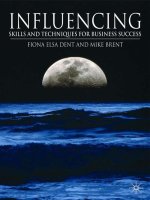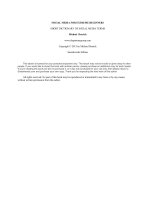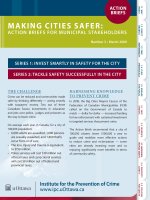Business Across Cultures Culture for Business Series_5 potx
Bạn đang xem bản rút gọn của tài liệu. Xem và tải ngay bản đầy đủ của tài liệu tại đây (1.35 MB, 25 trang )
Figure 3.12 shows the proportion who answered “a” (internal con-
trol).
Our database shows that Western cultures share extremely inter-
nally-controlled orientations. It is obvious that most Western
managers are selected on the competence (false or not) that essen
-
tially any environment can be controlled, any market created, and
any problem overcome by one’s own doing. You market what we
can produce, better known as technology push. Asians, who mostly
come from externally-oriented cultures, are supremely equipped to
be stimulated by signals from the markets. Correspondingly, they
operate under the handicap of often not being the ones pushing the
latest technological developments.
Thus the dilemma is between “selling what you can make” or “mak
-
ing what you can sell.”
94
BUSINESS ACROSS CULTURES
Figure 3.12 Internal versus external control: percentage selecting “what hap-
pens to me is my own doing.”
GENDER DIFFERENCES
The locus of control is one of the few value dimensions where men
and women score with any significant difference across cultures.
Both in the US as well as in Asia and Europe, males are significantly
more inner-directed than females (see Figure 3.13).
Women seem to be more motivated by external stimuli while men
seem to believe they are in control of their environment by superim
-
posing their views on it.
We use a range of questions of which the following is an example to
position people along this dimension:
Of the following two statements, which do you believe to be more in line
with your reality?
(a) Becoming a great success is a matter of hard work; luck has little or
nothing to do with it.
(b) Becoming a great success often depends on being in the right place at
the right time.
95
FURTHER VALUE DIMENSIONS
Figure 3.13 Gender differences – degree of internal control
Whilst men are equally divided, with 50 percent answering “a” and
50 percent answering “b,” 58 percent of women answer “b” (more
outer directed).
Internal versus External
Lowest (most important variable) Country
Industry
Job function
Religion
Gender
Age
Education
Highest (least important variable) Corporate Climate/Culture
RECONCILING INTERNAL AND EXTERNAL CONTROL
The major issue at stake is to connect the internally-controlled
culture, arising from the talent of technology push, with the exter-
nally-controlled world of market pull in order to achieve a culture of
96
BUSINESS ACROSS CULTURES
10/1
The Ultimate Niche:
markets without
any clients
1/10
At the mercy of
your clients
Adapting to the environment by
being pulled by the market
Controlling the environment
by pushing technology
0
10
10
Push the technology
through the demand
of your clients
Figure 3.14 Push through pull
inventiveness. If we take a consumer electronics company like
Philips, nobody will deny its great knowledge and inventiveness in
its specific technologies and the quality of its marketing. The problem
the company had faced was that its two major functional areas didn’t
seem to connect and communicate. The success of an organization is
dependent on the integration of both facets. The push of technology
needs to help to decide which markets you want to be pulled by. And
the pull of the market needs to help you to know what technologies to
push (see Figure 3.14).
YOUR OWN ORIENTATION ALONG THESE DIMENSIONS
Throughout chapters 2 and 3 we have sought to both explain each
value dimension and demonstrate how these can describe cultural
differences. After recognizing and respecting these differences, we
can begin to reconcile them. You can usefully think about your own
orientation along these dimensions and how your overseas business
partners would score. Then think about where there are differences
and ask yourself these questions: “What tensions do these differ-
ences produce?” and, thereby, “what dilemmas do I face because of
these differences?”
You may not be aware of the differences, or maybe you and others
have already been able to reconcile them. It is where these differ
-
ences occur that you will be faced with dilemmas – and these you
will have to reconcile. We offer our methodology as the route to the
solution.
97
FURTHER VALUE DIMENSIONS
CORPORATE CULTURE
Corporate culture
CHAPTER 4
C
ultural factors in business derive not only from differences
across national boundaries, but also from those within and
between organizations. For many managers, the culture of
their organization may dominate over national differences. Consider
a young Japanese manager, who typifies Japanese thinking and val
-
ues, working in Japan for a US company. When he gets promoted to a
significant management grade, he travels the world, visiting the HQ
in the US frequently. Now he spends his time working and interact
-
ing with peers, who may be of many different nationalities. It is not
their country or nationality differences that dominate, but what they
share in terms of the “way things are done in this organization.”
Their system of shared meaning is no longer from their countries of
birth but from their shared way of working together, from making
PowerPoint presentations to colleagues using an in-house style with
corporate logos to using their own “corporate language,” from talk-
ing in terms of short-term budgets (rather than longer-term Japanese
thinking) to e-mail protocols and resource planning systems.
The corporate culture of the organization is now the driver. “Man-
agement of culture” is now about creating a corporate culture in
which people will work together to achieve the organization’s goals,
reconciling dilemmas that originate from issues of corporate culture.
Of course, this is not free of (national) culture. An organization in
one part of the world with a society that ascribes status may choose
an organization model that builds initially upon ascription rather
than achievement. But what of the global company with a diverse
workforce? And what is the link between corporate culture and
business?
This chapter discusses how one can approach the role and assess
-
ment of organizational culture. The basic framework is to compare
the current corporate culture with some idealized state as a means of
101
eliciting the dilemmas which have to be reconciled. The ideal corpo
-
rate culture is therefore discussed in the context of business goals
and the dilemmas that it provokes.
DEFINING CORPORATE CULTURE
Organizational culture is an elusive concept, which has been sum
-
marized by Silvester, Anderson, and Patterson (1999). Definitions
include a system of publicly and collectively accepted “meanings,”
which operate for a group at a particular time (Trice and Beyer,
1984); a pattern of “basic assumptions” developed as the group or
organization learns to cope with its environment (Schein, 1996); and
more simply as “the way we do things around here” (Deal and Ken-
nedy, 1982). “Yet despite the numerous strategic and culture change
programs that have been initiated by organizations in recent years,
efforts directed at identifying specific, observable and therefore
measurable features of organizational culture have met with far less
success. Moreover, the transmission of cultural values also remains a
neglected area in organizational psychology and whereas attempts
have been made to measure culture at the team level, often called
‘group climate,’ there remains a dearth of research which focuses
upon deeper strata of shared culture in work groups” (Silvester,
Anderson, and Patterson 1999). The effect of this has been to miti
-
gate the clarity with which organizational culture, and in particular
culture change, is viewed.
Only recently have Hampden-Turner and Trompenaars (2000)
revealed new generalizable frameworks based on their extensive
research data that transcend these lower-order models.
THE ROLE OF CORPORATE CULTURE
Basic to understanding culture in organizations is that we can define
102
BUSINESS ACROSS CULTURES
culture as a series of rules and methods, which an organization has
evolved to deal with the regular problems that it faces. Organiza
-
tions face dilemmas in dealing with the tension between the existing
set of values and the desired ones – or between partners of a merger
or strategic alliance. While cultures differ markedly in how they
approach these dilemmas, they do not differ in needing to make
some kind of response. They share the destiny to face up to different
challenges of existence. Once the leaders have become aware of the
problem solving process, they will reconcile dilemmas more effec
-
tively and will therefore be more successful.
It is becoming more frequently recognized that organization devel-
opment and business process reengineering have failed too often
because they ignored aspects of (corporate) culture. However, sim-
ply “adding” the culture component does not suffice. This explains
perhaps why culture is very often ignored. Values are not artifacts
that can be added. They are continuously created by interactions
amongst people and are not “just out there” like rocks. As such, cul-
ture is only meaningful in the context in which the members of an
organization go about their daily work.
CORPORATE CULTURE IN MERGERS, ACQUISITIONS, AND
STRATEGIC ALLIANCES
Globalization through mergers, acquisitions, and strategic alliances
is big business – currently well over US$2,000 billion annually. They
are sought after more than ever, not only for the implementation of
globalization strategies but as a consequence of political, monetary,
and regulatory convergence. Even so, two out of three deals don’t
achieve anywhere near the expected benefits that prompted the ven
-
ture (Trompenaars and Woolliams, 2001).
It is common to acquire an organization with less concern for full
103
CORPORATE CULTURE
integration simply to purchase its inherent value. Increasingly how
-
ever, motives originate from a range of other expected benefits,
including synergistic values (e.g. cross-selling, supply chain consoli
-
dation, and economies of scale) or more direct strategic values (to
become market leaders, penetrating a ready-made customer base,
etc.). The emphasis in the pre-deal and post-deal management is too
often focused on seeking to exploit the new opportunities quickly
under a mechanistic systems or financial due-diligence mindset
(KPMG Consulting, 1999).
It is assumed that the task to deliver the benefits is to align the tech-
nical, operational, and financial systems and market approaches.
Our research reveals that the underlying failure to deliver the real
benefits arises from the absence of a holistic, structured, method-
ological framework. Because of this, senior management does not
know what to integrate or what types of decision are important in
order to deliver the anticipated benefits. Whilst any integration pro-
gram should be based on operational matters where the benefits are
being sought, much more attention and resource needs to be given
to managing the cultural differences between the new partners.
Relational aspects like cultural differences and lack of trust turn out
to be responsible for 70 percent of alliance failures. This is even more
striking when we realise that building trust is a cultural challenge in
itself. Lack of trust is often caused by different views of what consti
-
tutes a trustworthy partner. In addition, intercultural alliances
involve differences in corporate cultures as well as national cultures.
Problems can be due to more or less “objective” cultural differences,
but also to perceptions about each other, including perceptions of
corporate and national culture.
HR has a major role to play. Consideration must be given to leader
-
ship styles, management profiles, organizational structures, working
104
BUSINESS ACROSS CULTURES
practices, and a wide range of perceptions in and of the market
place. In short, culture is pervasive. Even when strategists and
senior managers recognise the importance of culture, frustration
continues because until now they have had no means of assessing or
quantifying its causes and effects, or of taking relevant effective
action.
Based on our extensive experience working with client companies
involved in such mergers and alliances, we have developed a new
methodology that we call Cultural Due Diligence. This provides an
operational framework in order that the consequences of corporate
culture clash can be made explicit and thereby reconciled to ensure
benefit delivery. It is again based on the three ‘R’s: Recognition,
Respect and Reconciliation.
MAJOR TENSIONS ORIGINATING IN
CORPORATE CULTURE
Much of our inductive thinking owes its origin to our portfolio of
effective diagnostic and analytical tools and models, and the large
and reliable database we have established. This enables either us to
facilitate or let organizations themselves diagnose the tensions they
are facing.
Structure is a concept that is frequently used in the analysis of orga
-
nizations and many definitions and approaches are to be found. Our
interest here is in examining the interpretations employees give to
their relationships with each other and with the organization as a
whole. Organizational culture is to the organization what personal
(seven dimensions model) culture is to the individual – a hidden yet
unifying theme which provides meaning, direction, and mobiliza
-
tion and that can exert a decisive influence on the overall ability of
the organization to deal with the challenges it faces.
105
CORPORATE CULTURE
Just as individuals in a culture can have different personalities while
sharing much in common, so too can groups and organizations. It is
this pattern that is recognized as “corporate culture.” Corporate cul
-
ture has a profound effect on organizational effectiveness, because it
influences how decisions are made, human resources are used, and
how the organization responds to the environment.
We can distinguish three aspects of organizational relationships
whose meaning is dependent on the larger culture in which they
emerge:
1. the general relationships between employees in the organiza-
tion;
2. the vertical or hierarchical relationships between employees
and their superiors or subordinates;
3. the relationships of employees in the organization as a whole,
such as their views of what makes it tick and what its goals are.
106
BUSINESS ACROSS CULTURES
People oriented
Task oriented
Egalitarian
Hierarchical
Incubator
Guided Missile
Eiffel Tower
Family
Figure 4.1 Four culture types
Our model identifies four competing organizational cultures that
are derived from two related dimensions:
•
Task or Person (high versus low formalization)
•
Hierarchical or Egalitarian (high versus low centralization)
Combining these dimensions gives us four possible culture types, as
shown in Figure 4.1.
THE EXTREME STEREOTYPES OF
CORPORATE CULTURE
107
CORPORATE CULTURE
The Incubator
This culture is like a leaderless team. This person-oriented cul-
ture is characterized by a low degree of both centralization and
formalization. In this culture, the individualization of all
related individuals is one of the most important features. The
organization exists only to serve the needs of its members.
An Incubator organization has no intrinsic values beyond
these goals; the organization is an instrument to the specific
needs of the individuals in the organization. Responsibilities
and tasks within this type of organization are assigned primar
-
ily according to the member’s own preference and needs.
Structure is loose and flexible and control takes place through
persuasion and mutual concern for the needs and values of
other members.
Its main characteristics are:
•
person oriented
•
power of the individual
108
BUSINESS ACROSS CULTURES
•
self-realization
•
commitment to oneself
•
professional recognition.
The Guided Missile
This task-oriented culture has a low degree of centralization
and a high degree of formalization. This rational culture is, in
its ideal type, task and project oriented. “Getting the job done”
with “the right person in the right place” are favorite expres-
sions. Organizational relationships are very results oriented,
based on rational/instrumental considerations and limited to
the specific functional aspects of the people involved.
Achievement and effectiveness are weighed above the
demands of authority, procedures, or people. Authority and
responsibility are placed where the qualifications lie, and they
may shift rapidly as the nature of the work changes. Every
-
thing in the Guided Missile culture is subordinated to an all-
encompassing goal.
The management of the organization is predominantly seen as
a continuous process of solving problems successfully. The
manager is a team leader, the commander of a commando unit,
in whose hands lies absolute authority. This task-oriented cul
-
ture, because of its flexibility and dynamism, is highly
adaptive but at the same time is difficult to manage. Decentral
-
ized control and management contribute to the shortness of
channels of communication. A task-oriented culture is designed
for a rapid reaction to extreme changes. Therefore matrix and
109
CORPORATE CULTURE
project types of organizations are favorite designs for the
Guided Missile.
Its main characteristics are:
•
task orientation
•
power of knowledge/expertise
•
commitment to tasks
•
Management by Objectives
•
Pay for Performance.
The Family
The Family culture is characterized by a high degree of central-
ization and a low degree of formalization. It generally reflects
a highly personalized organization and is predominantly
power-oriented. Employees in the Family seem to interact
around the centralized power of father or mother. Power is
based on an autocratic leader who, like a spider in a web,
directs the organization.
There are not many rules and thus there is little bureaucracy.
Organizational members tend to be as near to the center as
possible, as that is the source of power. Hence the climate
inside the organization is highly manipulative and full of
intrigue. In this political system, the prime logic of vertical dif
-
ferentiation is hierarchical differentiation of power and status.
Its main characteristics are:
110
BUSINESS ACROSS CULTURES
•
power-orientation
•
personal relationships
•
entrepreneurial
•
affinity/trust
•
power of person.
The Eiffel Tower
This role-orientated culture is characterized by a high degree of
formalization together with a high degree of centralization and
is symbolically represented by the Eiffel Tower. It is steep,
stately and very robust. Control is exercised through systems
of rules, legalistic procedures, assigned rights and responsibili-
ties. Bureaucracy and the high degree of formalization makes
this organization inflexible. Respect for authority is based on
the respect for functional position and status. The desk has
depersonalized authority.
In contrast with the highly personalized Family, members of
the Eiffel Tower organization are continuously subordinated to
universally applicable rules and procedures. Employees are
very precise and meticulous. Order and predictability are
highly valued in the process of managing the organization.
Duty is an important concept for an employee in this role-ori
-
entated culture. It is duty one feels within oneself, rather than
an obligation one feels towards a concrete individual.
Procedures for change tend to be cumbersome, and the role-
orientated organization is slow to adapt to change.
DIAGNOSING CORPORATE CULTURE WITH OUR CCAP
In the process of managing change it is of utmost importance to
diagnose the current culture in which the organization operates. As
Cameron and Quinn (1999) observe: “Unfortunately, people are
unaware of their culture until it is challanged, until they experience
a new culture, or until it is made overt and explicit through, for
example, a framework or model.” Measurements and assessment
using our model of four corporate cultures have been based on our
Corporate Culture Assessment Profile (CCAP) questionnaire; you
can review examples of questions from this CCAP tool on the Cul-
ture for Business website (www.cultureforbusiness.com). The CCAP
questionnaire has been constantly refined to achieve statistically sig
-
nificant levels of reliability and consistency, and we use this to chart
both current and ideal cultures along some important managerial
values. For strategic alliances and proposed mergers, we chart the
corporate cultures of the aspiring partners. Our four corporate ideol
-
ogies are based on well-grounded research ranging from Harrison to
Handy, and Cameron and Quinn.
These enable management to appreciate the set of values in use and
contrast them with the espoused or desired organizational values.
111
CORPORATE CULTURE
Its main characteristics are:
•
role-orientation
•
power of position/role
•
job description/evaluation
•
rules and procedures
•
order and predictability.
The CCAP is designed so that it measures some basic organizational
processes ranging from leadership styles, decision making, business
models, and the way people work in teams.
No real organization comprises exactly and completely any one of
the extreme stereotypes. The profiles seek to show the relative con
-
tributions of each. In most profiles of real organizations, some
contribution of all components is present to a greater or lesser
degree. The interest lies in which is the most dominant or in which
two quadrants dominate.
In order to triangulate our questionnaire results, key players (lead-
ers, change agents, internal consultants) are interviewed either
face-to-face or through our WebCue™ range of interactive web
pages. We engage senior management in “guided fantasies” such as
asking them to represent their current organization as an animal, car,
or famous television personality and to state the reasons why. On
the basis of these diverse inputs we assemble a picture of their domi-
nant cultural profile(s) that is subsequently codified in a feedback
report to the key players.
Research data from our 65,000 case database reveals that the domi-
nant current, as well as ideal, state is the task-oriented Guided
Missile. However after controlling for the different sizes of our sam
-
ples (Dutch, US, and UK samples are the largest) we see that the
distribution changes significantly.
What the current and ideal corporate culture is seems to be related to
a wide range of factors. At the detailed level, there are frequently
recurring differences across industries, functional areas, genera
-
tions, genders, and the propensity to encourage and enable innova
-
tion.
The corporate culture model also has links with the personal seven
112
BUSINESS ACROSS CULTURES
dimensions model explained in Chapters Two and Three. Thus the
relationship between employees in the Family or Incubator tends to
be diffuse and in the Eiffel Tower and Guided Missile it is more
specific. Status is ascribed more in Family and Eiffel Towers, while
Guided Missile and Incubator organizations are more achievement
oriented.
In order of increasing entropy (decreasing importance) the follow
-
ing tensions are found most often on our database:
Ideal
Guided Missile Incubator scenario 1
Eiffel Tower Guided Missile scenario 2
Family Guided Missile scenario 3
Eiffel Tower Incubator scenario 4
Family Incubator scenario 5
Incubator Guide Missile scenario 6
Managing organizational cultural differences is thus concerned with
answering two basic questions.
1. What are the dilemmas that will derive from the tensions
between the current and ideal corporate culture?
2. How can these dilemmas be reconciled?
Using our web-based interview techniques – WebCue™ – we have
invited members of a large number of client organizations to elicit
and delineate their dilemmas. We have collected over 7,500 such
responses and find that they can be clustered into a number of recur
-
ring dilemmas. As expected, different categories of dilemmas arise
for the different scenarios. We are therefore able to review these
aspects of organizational culture based on what we have found with
actual clients. The tensions from each scenario are generalized from
113
CORPORATE CULTURE
real client situations to avoid ethical issues and matters of confiden-
tiality. Figure 4.2 is a representation of the process, but the entry
point one chooses is culturally dependent.
Without doubt, survival of the business is ultimately the responsibil-
ity of the leadership of the organization (Schein, 1997). Not just the
responsibility of the very top, but also the responsibility of all those
who are able to connect actions with the survival of any particular
organizational activity: it is “multiple leadership” (Pettigrew, 1985).
In some respects, the pervasive nature of implicit culture can make it
difficult to manage. Even at the explicit level, traditional practices
become enshrined as “sacred cows” that cannot easily be chal
-
lenged. In an ideal world we would go back and challenge the
implicit values behind each of these explicit constructs in order to
check whether they were still the best way of delivering and rein
-
forcing those values. When the products of culture become sacred
114
BUSINESS ACROSS CULTURES
Implementing
new design and
define actions
Envisioned
future
Current
organizational
culture
Core values
Key purpose
Ideal
organizational
culture
Business
dilemmas
Reconciliation
process
Leadership
competence
Figure 4.2 Flow of cultural change process
cows they can inhibit survival, growth, and change. This is espe
-
cially important when importing your sacred cows to new cultures.
As the culture of an organization is often “owned” and lived at the
highest level, managers can feel they have little ability to influence
the real culture of the organization in a material way without some
top-down action.
We might summarize these extremes by saying that on the one hand
we need to change the corporate culture to be convergent with our
new business mission, while, on the other hand, we need to develop
a new business mission that is compatible with our existing corpo-
rate culture.
THE ENVISIONED FUTURE
This is what the organization aspires to become, to achieve, to cre-
ate – something that will require progress to attain. The more
specific BHAG (Big, Hairy, Audacious Goal) is a bold mission to
stimulate progress. It needs to be clear and compelling and serves as
a unifying focal point of effort. It should be able to engage people by
being tangible, energizing, and highly focused. A “vision-level”
BHAG applies to the entire organization. Setting it 10–30 years in the
future requires thinking beyond the current capabilities of the orga
-
nization and the current environment. It forces an executive team to
be visionary rather than just strategic or tactical. It should not be a
sure bet, but the organization must believe that it can reach the goal
anyway.
In our professional practice we have found that the development of
a “vivid description” translates the vision into rich pictures (both
vibrant and engaging), creating an image people can carry around in
115
CORPORATE CULTURE
their heads. Once we have attained a level of passion, emotion, and
conviction, we are ready to transcend the value side of the equation.
MAPPING CORPORATE CULTURE TO THE
BUSINESS FUTURE
All the inputs of the envisioned future – core values and key pur
-
pose and between current and ideal corporate cultures – form the
ingredients that are available to stimulate management to think
about what basic dilemmas they need to resolve in seeking to man-
age tensions that owe their origin to issues of corporate culture.
We often invite our participants to frame the tensions they feel in
actual business life and then relate them to the tensions they feel
between current and ideal cultures. For example, as an actual busi-
ness tension it is felt that: “Our organization is so much focused on
next-quarter results, we don’t have enough time to be creative and
come up with our next generation of innovations.” This example
would translate as the current corporate culture being a Guided Mis-
sile and the dominant espoused profile, an Incubator.
We often find that an extant organizational culture has developed
because the context best suited the main dilemmas their leaders
were facing in business. For example, an Incubator culture is often
the result of a leader who strives for a core value of entrepreneurship
and innovation while having an envisoned future of becoming the
most groundbreaking organization in the field of cross-cultural
management thinking and consulting. A Guided Missile culture is a
much better suited context for leaders who want to help clients gain
the highest return on their investments in the financial services sec
-
tor, holding a core value of integrity and transparency.
But business environments and challenges are changing continu
-
116
BUSINESS ACROSS CULTURES
ously. Once an organizational culture has established itself, it creates
new dilemmas (or its changing environment will) on a higher level.
For example, a dominant Incubator culture can create a business
environment where many innovative ideas are born but where the
management and commercialization of these draws on aspects of a
more market-sensitive and directed Guided Missile culture. Con
-
versely, a dominant Guided Missile Culture can lead to an
environment where employees are so much guided by their market
price that it needs a Family culture to create the necessary lon
-
ger-term vision and commitment.
First we capture the lists of what the key members of the organiza-
tion (usually the top 25–50 leaders) want more of or want to keep of
their current culture and of their ideal culture. Subsequently we ask
them to select, in groups of five or six people, the three top current
and ideal values, roles and/or behaviors in the light of both the
envisioned future and the core values and key purpose. We ask a
representative of each group to share their selections to the other
groups upon which we select four or five values/behaviors on both
current and ideal corporate profiles. Again we emphasize that the
selection is done in the light of an envisioned future and core ideol-
ogy. By doing this we assure that the selection of values and
behaviors is done in a business context.
We present the results of this step in the following way:
On the one hand we want more of
and/or to keep the following values
and behaviors of our current
organization:
1.
2.
3.
4.
5.
On the other hand we need to
develop the following values and
behaviors for supporting our
envisioned future and core values:
1.
2.
3.
4.
5.
117
CORPORATE CULTURE
The lists are presented to the full group and again we split them into
syndicates of five or six participants, this time with the request that
they formulate two fields of tension (dilemmas) that are crucial for
them to reconcile for critical success in view of the envisioned
future. We make sure that the formulation of the horns of the
dilemma are both equally desirable and are linked to business
issues.
Here are some examples:
•
“On the one hand, we need to focus on reliable technology
[typical for a dominantly Eiffel Tower Culture], whilst on the
other, we need to be constantly informed by our main custom-
ers [typical for one dominantly Guided Missile].”
• “On the one hand, we need to mentor and coach our young
graduates for constant learning [Incubator], whilst on the
other hand, we need to focus on the income of this quarter
[Guided Missile].”
• “On the one hand, we need to develop and sustain a loyal
workforce and thrive on rapport [Family], whilst on the other
hand, we need to be able to judge their performance based on
report [Guided Missile].”
It is crucial to this process that the chosen dilemmas are well formu
-
lated and support the crucial business challenges the organization is
facing. Finally we ask the full set of participants to select four or five
key dilemmas from which they can choose the one they want to rec
-
oncile in the next step.
Whilst this process assumes the availability and commitment of all
appropriate leaders and managers, we can also accelerate this pro
-
cess – for example if those that need to be involved are spread across
the globe. In this case we review the raw dilemmas from our web-
118
BUSINESS ACROSS CULTURES









